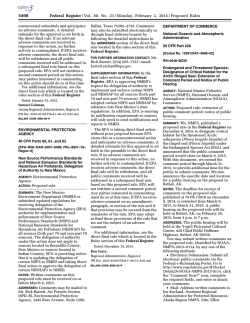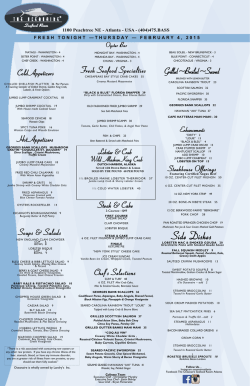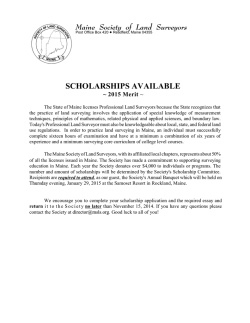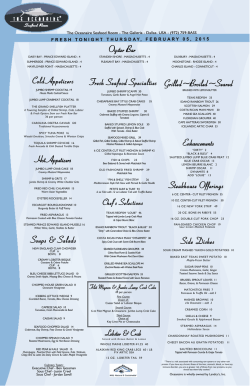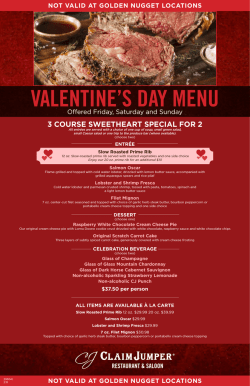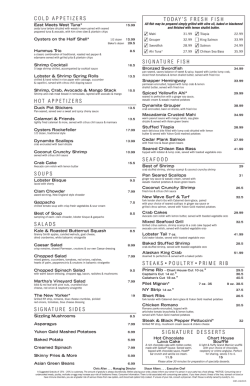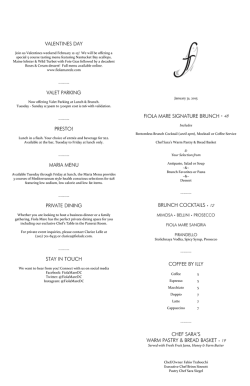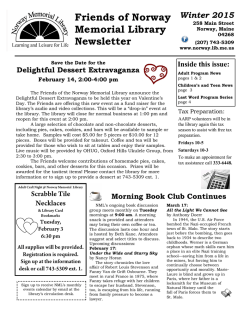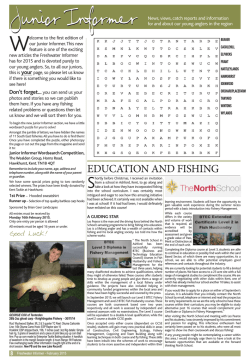
1 Billing Code: 3510-22-P DEPARTMENT OF COMMERCE National
This document is scheduled to be published in the Federal Register on 02/03/2015 and available online at http://federalregister.gov/a/2015-02041, and on FDsys.gov Billing Code: 3510-22-P DEPARTMENT OF COMMERCE National Oceanic and Atmospheric Administration RIN 0648-XD647 Fisheries of the Caribbean, Gulf of Mexico, and South Atlantic; Snapper-Grouper Fishery off the Southern Atlantic States, Dolphin and Wahoo Fishery off the Atlantic States, and Coral and Coral Reefs Fishery in the South Atlantic; Exempted Fishing Permit AGENCY: National Marine Fisheries Service (NMFS), National Oceanic and Atmospheric Administration (NOAA), Commerce. ACTION: Notice of receipt of two applications for exempted fishing permits; request for comments. SUMMARY: NMFS announces the receipt of two applications for exempted fishing permits (EFPs), one from Dr. Janelle Fleming, on behalf of the Eastern Carolina Artificial Reef Association (ECARA); and one from Dr. James Morris of the National Ocean Service (NOS). If granted, the EFPs would authorize the deployment of Maine lobster traps, crab pot Christmas trees, and horizontal structures (fish attracting devices) at several sites in the Federal waters off North Carolina to determine the efficacy of these gear types for attracting and collecting invasive lionfish. DATES: Written comments must be received on or before [insert date 30 days after publication in the FEDERAL REGISTER]. 1 ADDRESSES: You may submit comments on the applications, identified by "NOAA-NMFS-2015-0018", by any of the following methods: • Electronic Submission: Submit all electronic public comments via the Federal e-Rulemaking Portal. Go to www.regulations.gov/#!docketDetail;D=NOAA-NMFS-2015-0018, click the “Comment Now!” icon, complete the required fields, and enter or attach your comments. • Mail: Submit written comments to Kate Michie, Southeast Regional Office, NMFS, 263 13th Avenue South, St. Petersburg, FL 33701. Instructions: Comments sent by any other method, to any other address or individual, or received after the end of the comment period, may not be considered by NMFS. All comments received are a part of the public record and will generally be posted for public viewing on www.regulations.gov without change. All personal identifying information (e.g., name, address, etc.), confidential business information, or otherwise sensitive information submitted voluntarily by the sender will be publicly accessible. NMFS will accept anonymous comments (enter "N/A" in the required fields if you wish to remain anonymous). Attachments to electronic comments will be accepted in Microsoft Word, Excel, or Adobe PDF file formats only. FOR FURTHER INFORMATION CONTACT: Kate Michie, 727-824-5305; e-mail [email protected]. 2 SUPPLEMENTARY INFORMATION: The EFP is requested under the authority of the Magnuson-Stevens Fishery Conservation and Management Act (16 U.S.C 1801 et seq.), and regulations at 50 CFR 600.745(b) concerning exempted fishing. The fishing activities proposed under each EFP are similar in nature; therefore, both EFP requests are being announced in a single Federal Register notice. However, NMFS will consider each application separately and make independent determinations about whether to issue each EFP. The EFP requests involve activities covered by regulations implementing the Fishery Management Plans (FMP) for federally managed fisheries of the South Atlantic Region, which prohibit the use of fish traps in the South Atlantic (50 CFR 622.9). The ECARA request authorization to deploy two sets of five Maine lobster traps with crab pot Christmas trees. The NOS applicant requests authorization to deploy one set of five Maine lobster traps with crab pot Christmas trees and horizontal structures. Crab pot Christmas trees are a vertical, pyramid-shaped structure with many branch-type projections. Crab pot Christmas trees would be used as fish attracting devices in both projects. The horizontal structures are horizontal and concave structures elevated off the bottom with four legs similar to an upside down satellite dish or a small round table. This structure type has been documented to attract large aggregations of lionfish. In both projects, the Maine lobster traps 3 and accompanying attracting devices would be set along artificial reef sites, natural reef sites, rocky reef bottom, and a flat sandy area in Federal waters off North Carolina. The ECARA applicant has requested the EFP be effective from the date of issuance through December 31, 2016, and the NOS applicant has requested the EFP be effective from the date of issuance through December 31, 2018. The purpose of these studies are to support continued research on traps that could be used for collecting invasive lionfish off eastern North Carolina artificial reefs, and to determine their efficacy as fish attracting devices. Additionally, the ECARA project intends to assess consumers’ preference for lionfish as an exotic food source in a restaurant setting to determine if Carteret County, NC, would support a consumer market for the species. In both studies, each string of five Maine lobster traps and crab pot Christmas trees/horizontal structures will be connected by a chain with no buoy lines to the surface, and deployed along designated hard bottom features with a distance of 30 ft (9.14 m) to 50 ft (15.24 m) between each trap. After deployment, divers will verify the position of the traps to ensure the traps are located between 20 ft (6.10 m) and 30 ft (9.14 m) from the designated bottom feature. Trap deployment would occur year-round along the North Carolina coast from 3 miles offshore, and up to 360 ft (109.68 m) 4 in depth. The traps will be deployed for at least 48 hours and no longer than 3 weeks. After 48 hours, divers will count and identify the number of fish inside and around the traps, and record video prior to hauling the traps. Video images will be used to assess the success of the crab pot Christmas trees and horizontal structures as attracting devices for lionfish, and other fish species. Under the ECARA project, fish captured in the Maine lobster traps will be quantified to the lowest possible taxon, measured, photographed/video documented, and released alive. Any egg bearing lobsters captured in a trap will be returned to the water and released alive. Captured lionfish will be counted, measured, and prepared for consumption at nearby restaurants. These lionfish will be offered, free of charge, to patrons as part of the consumer demand assessment portion of the research project. Under the NOS project, fish caught in the Maine lobster traps will be removed from the traps, returned to the water and released alive. NMFS finds these applications warrant further consideration based on a preliminary review. Possible conditions the agency may impose on this permit, if they are granted, include but are not limited to, a prohibition of conducting research within marine protected areas, marine sanctuaries, special management zones, or artificial reefs without additional authorization, and use of escape 5 panels on the Maine lobster traps. Additionally, NMFS will require any sea turtles taken incidentally during the course of fishing or scientific research activities to be handled with due care to prevent injury to live specimens, observed for activity, and returned to the water. A final decision on issuance of each of the EFPs will depend on NMFS' review of public comments received on the application, consultations with the affected state, the South Atlantic Fishery Management Council, and the U.S. Coast Guard, and a determination that they are consistent with all applicable laws. Authority: 16 U.S.C 1801 et seq. Dated: January 29, 2015. _______________________ Alan D. Risenhoover, Director, Office of Sustainable Fisheries, National Marine Fisheries Service. 6 [FR Doc. 2015-02041 Filed 02/02/2015 at 8:45 am; Publication Date: 02/03/2015] 7
© Copyright 2025
